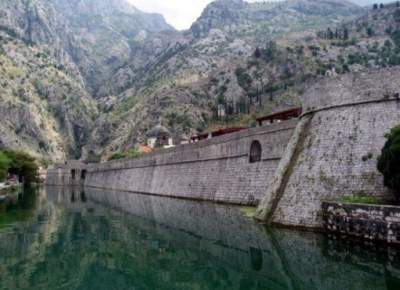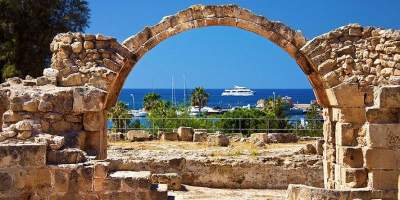 The country is breathtakingly beautiful and unusual places, Montenegro is not able to disappoint those who come here to see something amazing and extraordinary!
The country is breathtakingly beautiful and unusual places, Montenegro is not able to disappoint those who come here to see something amazing and extraordinary!
Today we will introduce you with some of the best attractions which should be seen by every tourist while visiting this amazing country of Montenegro.
10. Transformers Podgorica, Podgorica (Podgorica)

Montenegro is not a place of actual landing of transformer robots, but has some amazing robots created in the framework of street art project.
Seven of the 14 meters high was created by local young sculptor Balticum Danilo (Danilo Baletic), childhood is a fan of cartoons about robots.
Within two years, with the direct assistance of his father, he created from scrap, old and unwanted car and truck parts found at the dump, huge transformers, which became decoration of the city’s main square.
9. The monument to the victims of the war in Ulcinj (Ulcinj War Memorial), Ulcinj

With this impressive monument, erected in the form of two wings, offers beautiful views of the city, located at the bottom.
The resort town of Ulcinj has a rich history, so the architecture of the city is represented in all their diversity. This monument to war victims, in particular on period, which is immortalized in his sculpture.
The monument, located at the edge of the top of the mountain, which pays tribute to the Yugoslav air forces, bravely fought in the war.
A unique monument resembles the wings of a bird or perhaps a plane’s wings, which seemed to continue to protect the beach Mala Plaža beach (Mala Plaza), located down at the foot. Ulcinj is a very popular summer vacation place for many Europeans: Albanians, Germans and Italians.
8. Fortifications of Kotor (Kotor)

Kotor is so ancient that many historians believe that the city that is now actually built on top of the city that was here once! That’s it! City in the city! These ancient fortifications were provided to the city protected for hundreds of years of occupation, sieges and invasions.
Located on the shore of Kotor Bay, a natural fjord off the coast of the Adriatic sea, Kotor is the oldest town in Montenegro, whose history go to the ancient world. Archaeologists are not quite sure, but it may have been built on top of another city in the period between 700 and 400 BC
Until now, there have been discussions about the town’s early history, which is still unclear, but historians are unanimous regarding the fact that Kotor was colonized by Greeks, beginning with the III century BC.
Natural steps and slopes of the hills were used by ancient people as the proper protection, but in the eyes rush and the construction of walls, most of which were built under the influence of Venetian architecture in the period from 1420 to 1797 Kotor was under the control of the Venetian Republic). The city is ancient, but its defensive structures, mostly medieval.
The list of invaders of Kotor are very impressionable: the Illyrians, Romans, Venetians, Turks, Austrians, Britons, Hungarians and others. The walls have undergone not only the numerous attacks and the occupation of the enemies, but a major earthquake in 1979, which significantly damaged their structure. However, these impressive fortifications attracted the attention of many tourists every year.
7. Ostrog Monastery (Ostrog)

Once Orthodox Christians built temples and churches in the mountains to hide from enemies. While most of them were quite small, some, such as the Ostrog monastery, had impressive size.
1600 years was a turbulent time in the Balkans. The small Principality of Montenegro was fighting for survival against the mighty Ottoman Empire. Under the threat of the Ottoman invasions, many Orthodox Christians went to the mountains.
Ostrog monastery was carved in a vertical mountain slope Ostroska Greda (Ostroška greda). The monastery was founded in the XVII century Basil, Bishop of Herzegovina, later known as Saint Basil of Ostrog. His relics are kept in the ark in a cool, dark walls of Vvedensky of a temple located in a cave monastery complex of Ostrog.
Rumors about the miraculous curative power of his Holy remains were spread very quickly, and the monastery became a center of pilgrimage not only among Orthodox, but also among Catholics and Muslims.
The pilgrimage continues to this day: Jail still takes visitors to different faiths, the greatest influx which occurs in the Trinity.
Most of the modern appearance of the rock monastery dated back to the years 1923-26, when after the fire was the reconstruction of the complex. The monastery was badly damaged in the fire, but, fortunately, the two main rock chapels escaped the sad fate and remain in its original condition.
6. Gospa-od-Skrpjela (Gospa od Skrpjela), the Bay of Kotor

This amazing island, whose name can be translated as “the mother of God on the rock”, was once nothing but a small reef, but after two brothers, a sailor found it on the icon of the virgin, which cured one of them, this place was special.
The island of Gospa od-Skrpjela is one of two tiny Islands located in the waters of the Boka Kotorska Bay, near Perast (Perast). The distinctive feature of these Islands is that they are man-made.
Once the island was only a small reef. In the place where the brothers Mortality in July 1452, it found the image of the virgin Mary, was erected a tiny Orthodox chapel.
For two centuries the inhabitants of Perast flooded in this place the old and the captured pirate ships. In addition, according to the law, with every passing by the reef the ship had to be dropped to the bottom of the stone. In the end it was created a plateau with an area of slightly more than 3 thousand square meters. The Church of the mother of God, built in the Byzantine style, rises to 11 metres.
The custom to throw stones on the bottom near the island of Gospa od-Skrpjela preserved to the present day — it’s called fasinada”. It has not only symbolic value but also important from a practical point of view: thanks to the “fasinada” manages to stop the erosion of the artificial island by sea.
In addition, it is also the name of the annual holiday in Perast on July 22, during which the regatta is held on the Cup Pasenadi.
5. Fort Mamula Island Mamula (Mamula Island)

This amazing Hungarian military fortress was built in 1853 and, although today it is abandoned and isolated, thousands of tourists still visit it every year.
The island fortress, built by order of Governor of the Kingdom of Dalmatia, General Lazar Mamula, has an almost round shape and small size: only about 200 metres in diameter. This size, however, did not prevent him from becoming impregnable Fort, the walls of which sheltered the garrison, easily stopping the attack from the sea.
Fort Mamula, unfortunately, not always fulfilled the protective function of the First and Second world wars it was turned into a prison, which prisoners — fighters for a free Montenegro — were subjected to cruel torture.
Today, the island fortress is under state protection, making it a popular place to visit among tourists and passing cruise ships.
4. Old olive tree (Stara Maslina), Tomba (Tomba)

The majority of olive trees are beautiful, but not all deserve to be famous. This tree is one of those: it is more than 2,000 years!
One of the oldest olive trees on the planet grows close to Stari Bar (Stari Bar), in the area called Tomba.
The ancient tree has a spectacular view and consists of several trunks, which are so intertwined with each other that turned into a complex architectural design. Unfortunately, the part of the tree burnt by lightning.
It is noteworthy that the old olive tree, protected by the state, is still fruit-bearing.
3. Cetinje-Kotor road (Cetinje-Kotor Road)

Considered one of the most beautiful roads Cetinje-Kotor road is twisty, winding track that goes up or down the slope of the mountain, which offers breathtaking views of the valley.
This is one of the most unusual roads not only in Montenegro but throughout the region. Traveling the old Cetinje-Kotor road, you’ll pass through the famous turns of the serpentine Luchanskogo, the beauty of which impresses many.
It is said that this route by the architect Josip-Hand (Josip Slade) dedicated to the Duchess Milena, thus perpetuating her name in the side of the road, which was built in the shape of the letter “M”.
2. The mausoleum of Petar II (Mausoleum of Petar II), Njegus (Njeguši)

Located on top of a hill, this amazing mausoleum of Petar II Petrovic-Njegos is full of contradictions and surprise. In the mausoleum is the tomb of the last spiritual ruler of Montenegro who have expressed a desire to be buried in the chapel which he founded on mount Lovcen.
However, fearing a possible attack on the tomb by the Turkish Pasha of Skadar, ruler, who died in 1851, it was decided to bury in Cetinska monastery. A few years later his remains were moved to the chapel on mount Lovcen.
During the First world war, captured the mountain Lovcen Austro-Hungarian army bombed the chapel, located on top of the remains of Peter II Petrovic-njegoš shortly before it was again transferred to the Cetinje monastery).
In the mid-1920s, years its reconstruction has been completed, but two decades later, the authorities of Yugoslavia, 100-year anniversary of the death of Peter II petrović-njegoš took the decision to demolish the chapel and on its place to construct a new building. This caused much controversy, because this would contradict the original desire njegoš, who wished to be buried in the chapel he founded.
In 1974 on the site of the demolished chapel was built the mausoleum, which is a low-rise building of stone, the entrance to which is guarded by two statues of Chernomorec. On the lower floor of the mausoleum, the roof of which is covered with gold, is the sarcophagus of Peter II Petrovic-Njegos. Inside the mausoleum you can see the 28-ton statue of the ruler.
1. The Resort Of Sveti Stefan (Sveti Stefan Resort, Budva (Budva)

No trip through strange places in Montenegro would be complete without a night at the island hotel! Yes, it’s a resort island, and it is not allowed nobody but those who settled in the 5-star rooms!
The isthmus between the mainland and the island on which is situated the resort of Sveti Stefan, is a natural: it was the result of the layered alluvium of gravel, which is a rare natural phenomenon.
The first mention of the fortress dates back to the year 1442. After the victory over the Ottomans who were trying to seize involved, residents of the local villages Petrovic decided to build a fortress and Church in honor of St. Stephen.
For a long time, the island was a traditional fishing village until the mid-twentieth century due to the economic crisis, residents of dilapidated town was resettled to the mainland, and Sveti Stefan was reconstructed in the exclusive town-hotel.
On the island there are about 80 buildings, including three historic churches, one of which is the Church of St. Stephen.








